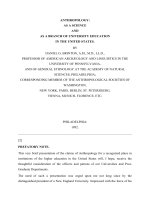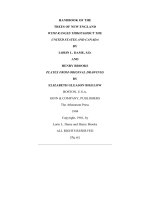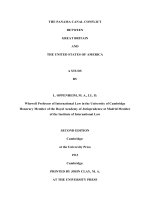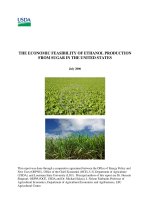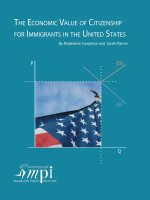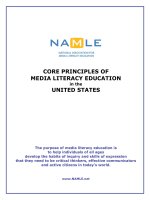The Role Of The United States Postal Service In Public Safety And Security doc
Bạn đang xem bản rút gọn của tài liệu. Xem và tải ngay bản đầy đủ của tài liệu tại đây (1.01 MB, 221 trang )
This document and trademark(s) contained herein are protected by law as indicated
in a notice appearing later in this work. This electronic representation of RAND
intellectual property is provided for non-commercial use only. Unauthorized
posting of RAND PDFs to a non-RAND Web site is prohibited. RAND PDFs are
protected under copyright law. Permission is required from RAND to reproduce,
or reuse in another form, any of our research documents for commercial use. For
information on reprint and linking permissions, please see RAND Permissions.
Limited Electronic Distribution Rights
Visit RAND at www.rand.org
Explore the RAND Safety and Justice Program
View document details
For More Information
This PDF document was made available
from www.rand.org as a public service of
the RAND Corporation.
6
Jump down to document
THE ARTS
CHILD POLICY
CIVIL JUSTICE
EDUCATION
ENERGY AND ENVIRONMENT
HEALTH AND HEALTH CARE
INTERNATIONAL AFFAIRS
NATIONAL SECURITY
POPULATION AND AGING
PUBLIC SAFETY
SCIENCE AND TECHNOLOGY
SUBSTANCE ABUSE
TERRORISM AND
HOMELAND SECURITY
TRANSPORTATION AND
INFRASTRUCTURE
WORKFORCE AND WORKPLACE
The RAND Corporation is a nonprofit
research organization providing
objective analysis and effective
solutions that address the challenges
facing the public and private sectors
around the world.
Purchase this document
Browse Books & Publications
Make a charitable contribution
Support RAND
This product is part of the RAND Corporation monograph series.
RAND monographs present major research findings that address the
challenges facing the public and private sectors. All RAND mono-
graphs undergo rigorous peer review to ensure high standards for
research quality and objectivity.
Lois M. Davis, Michael Pollard, Jeremiah Goulka,
Katherine Mack, Russell Lundberg, Paul Steinberg
Sponsored by the United States Postal Service
A RAND INFRASTRUCTURE, SAFETY, AND ENVIRONMENT PROGRAM
Safety and Justice
The Role of the
United States Postal
Service in Public
Safety and Security
Implications of Relaxing the
Mailbox Monopoly
The RAND Corporation is a nonprofit research organization providing
objective analysis and effective solutions that address the challenges
facing the public and private sectors around the world. RAND’s
publications do not necessarily reflect the opinions of its research clients
and sponsors.
R
®
is a registered trademark.
© Copyright 2008 RAND Corporation
All rights reserved. No part of this book may be reproduced in any
form by any electronic or mechanical means (including photocopying,
recording, or information storage and retrieval) without permission in
writing from RAND.
Published 2008 by the RAND Corporation
1776 Main Street, P.O. Box 2138, Santa Monica, CA 90407-2138
1200 South Hayes Street, Arlington, VA 22202-5050
4570 Fifth Avenue, Suite 600, Pittsburgh, PA 15213-2665
RAND URL:
To order RAND documents or to obtain additional information, contact
Distribution Services: Telephone: (310) 451-7002;
Fax: (310) 451-6915; Email:
This research was sponsored by the United States Postal Service and was
conducted under the auspices of the Safety and Justice Program within
RAND Infrastructure, Safety, and Environment (ISE).
Library of Congress Cataloging-in-Publication Data
The role of the United States Postal Service in public safety and security : implications
of relaxing the mailbox monopoly / Lois M. Davis [et al.].
p. cm.
ISBN 978-0-8330-4615-4 (pbk. : alk. paper)
1. United States Postal Service. 2. Postal service—United States—Safety
measures. I. Davis, Lois M.
HE6371.R58 2008
363.1—dc22
2008044821
iii
Preface
e United States Postal Service (USPS) has long held statutory
monopolies to deliver mail and to require that only U.S. mail be deliv-
ered to the mailbox. While the USPS has defended its monopolies as
necessary to fulfill its mission to provide service to every delivery point
in the United States, several critics have argued against the monopo-
lies, primarily on economic, antimonopoly grounds related to leveling
the playing field for other competitors and on property rights grounds
for mailbox owners. However, sometimes lost in the economic debate
surrounding the monopolies is the fact that relaxing the monopolies
may have ramifications in other areas—in particular, public safety and
security. When it comes to delivering mail, there are several possible
public safety and security concerns, including, for example, mail fraud,
identity theft, and even terrorism, as demonstrated by prior use of the
mail to send letter bombs and anthrax.
Given the potential public safety and security concerns, the USPS
asked the RAND Corporation to assess the security implications of
relaxing the USPS’s monopoly on delivering to the mailbox (known
variously as the Mailbox Restriction, the Mailbox Rule, or the Mailbox
Monopoly) to allow private couriers to deliver directly to mailboxes as
well. Specifically, the project addresses whether relaxing the Mailbox
Rule would present a public safety risk to carriers, couriers, and cus-
tomers. To do so, RAND researchers used a combination of qualitative
analyses (e.g., literature review, key-actor interviews with USPS staff
and external experts, and a survey of consumers) and descriptive quan-
titative analyses (e.g., of incident databases collected by the United
iv The Role of the United States Postal Service in Public Safety and Security
States Postal Inspection Service, or IS). However, it is important to
note that all of our statements with regard to private couriers and com-
parisons to the USPS are based solely on publicly available documents
and some suggestive data from the IS incident database. Without other
detailed, direct information from the couriers, similar to that provided
by the USPS, we can only infer what their current capacity is for man-
aging safety and security issues in the processing and delivery process.
is research should be of interest to policymakers, Congress, and
the private sector.
The RAND Safety and Justice Program
is research was conducted under the auspices of the Safety and
Justice Program within RAND Infrastructure, Safety, and Environ-
ment (ISE). e mission of RAND Infrastructure, Safety, and Envi-
ronment is to improve the development, operation, use, and protec-
tion of society’s essential physical assets and natural resources and to
enhance the related social assets of safety and security of individuals
in transit and in their workplaces and communities. Safety and Justice
Program research addresses occupational safety, transportation safety,
food safety, and public safety—including violence, policing, correc-
tions, substance abuse, and public integrity.
Questions or comments about this monograph should be sent
to the project leader, Lois Davis (). Information
about the Safety and Justice Program is available online (http://www.
rand.org/ise/safety). Inquiries about research projects should be sent to
the following address:
Greg Ridgeway, Acting Director
Safety and Justice Program, ISE
RAND Corporation
1776 Main Street
Santa Monica, CA 90407-2138
310-393-0411, x7734
v
Contents
Preface iii
Figures
ix
Tables
xi
Summary
xiii
Acknowledgments
xxiii
Abbreviations
xxv
CHAPTER ONE
Introduction 1
Background
1
Study Approach
2
Study Limitations
3
Organization of is Monograph
5
CHAPTER TWO
e USPS’s Monopolies and Its Role in Public Safety 7
Introduction to the USPS Monopolies
7
e Mailbox Rule
8
e Postal Monopoly
9
What Happens If the Mailbox Rule Is Relaxed?
11
e Public Safety and Security Roles of the USPS and Private
Couriers
14
National Response Framework and Cities Readiness Initiative
14
National Infrastructure Protection Plan
15
Customs-Trade Partnership Against Terrorism
15
Carrier Alert
16
vi The Role of the United States Postal Service in Public Safety and Security
Public Safety Education and Awareness 16
e Role of the IS in Public Safety and Security
20
CHAPTER THREE
Relaxing the Mailbox Rule: Effect on Public Safety and Security
Incidents
23
Types of Security Incidents and Trends
24
Volume Attacks
26
Fraud
29
Financial Crime
32
Suspicious Incidents
36
Improvised Explosive Devices (Bombs)
40
Differences Between the USPS and Private Courier Companies in
Training, Public Accountability, and Oversight
41
Federal Regulations at Apply to Both the USPS and Private
Couriers
42
Differences in Training
43
Differences in Oversight and Accountability Mechanisms
57
Security Implications of Relaxing the Mailbox Rule
59
General Implications of Relaxing the Mailbox Rule
59
Relaxing the Mailbox Rule: Implications for Security Incidents
61
Summary
65
CHAPTER FOUR
Relaxing the Mailbox Rule: Effect on the IS’s Ability to Detect,
Deter, and Investigate Crime
67
Relaxing the Mailbox Rule: Effect on Federal Jurisdiction Over Mail
68
“Mail” and the Mailbox
68
Diversion of Mail to Private Couriers
72
Relaxing the Mailbox Rule: Effect on Investigation Costs
75
Relaxing the Mailbox Rule: Effect on Tracking Trends in Mail Crime
76
Relaxing the Mailbox Rule: Effect on the Ability to Deter Crime
78
Does Enforcement of the Mailbox Rule Deter the Acts It Proscribes?
78
Does Enforcement Deter Crimes at the Mailbox?
80
Do the USPS and IS Deter Crimes at Might Be Diverted to
Private Couriers?
81
Contents vii
Summary 83
CHAPTER FIVE
Public Perceptions About Relaxing the Mailbox Rule 85
Methods
86
Key Survey Findings
88
Most Respondents Have a Positive Perception of the USPS
88
Most Respondents Oppose Removing the Mailbox Rule
90
Security Is One Concern Among Many
95
Households More Likely to Be Affected Are Less Opposed
102
Summary
106
CHAPTER SIX
Conclusions and Issues for Further Consideration 109
Conclusions
109
Issues to Be Considered If the Mailbox Rule Were Relaxed
112
APPENDIXES
A. Methods 115
B. Detailed Tables of Incidents
127
C. Guidelines and Training
145
D. Differences Between FTC and IS Fraud Data
177
References
181
ix
Figures
3.1. Cluster-Box Units, One Type of Multiple-Mailbox
Delivery Point
27
3.2. e Postal System: Where Do USPS Training, Safety and
Security Measures, and Public Education Campaigns
Matter Most?
44
xi
Tables
2.1. USPS Guidance and Training to Private Businesses and
the Public
17
3.1. Volume Attacks, by Year
27
3.2. Volume Attacks, by Sociodemographic Context
28
3.3. Types of Fraud Schemes
29
3.4. Reported Fraud Incidents, by Year
31
3.5. Reported Fraud Incidents, by Sociodemographic Context
32
3.6. Selected Types of Financial Crime
33
3.7. Reported Financial Crime Incidents for 2006–2007
34
3.8. Reported Financial Crimes, by Sociodemographic
Context for 2006–2007
35
3.9. Suspicious Incidents, by Year
36
3.10. Percentage of Incidents in Which the IS Was Involved
38
3.11. IEDs, by Year
40
3.12. USPS Employee Guidance and Training
46
5.1. Perceptions of the USPS Brand
89
5.2. Preference for Access to the Mailbox: GAO Version
91
5.3. Preference for Access to the Mailbox: USPS Version
92
5.4. Preferences for Mailbox Access for ose Who Receive
Mail rough a Door Slot
94
5.5. Reasons to Oppose Increased Access
96
5.6. Perceptions of Mailbox Access, by Level of Concern
About Mailbox Security
96
5.7. Perceptions of Mailbox Exclusivity, by Level of Concern
About Mailbox Security
97
5.8. Increasing Access to Private Companies Increases
Concerns About Security
98
5.9. Concern About Security of the Mailbox and Mail Security
99
xii The Role of the United States Postal Service in Public Safety and Security
5.10. Perceptions of Mailbox Access, by View of the Security
Impact of Increasing Access
99
5.11. Reasons for Opposing Access: Difference Between ALP
and Hart Surveys
100
5.12. More Security Information Leads to Greater Citations of
Security
101
5.13. Rural and Urban Views of Mailbox Access
103
5.14. Rural and Urban Reasons for Opposing Increased Access
104
5.15. Rural and Urban Perceptions of the USPS
104
5.16. Rural and Urban Perceptions of Mailbox and Mail
Security
105
5.17. Rural and Urban Perceptions of Security with Increased
Private Access
105
B.1. Volume Attacks, by Year
127
B.2. Volume Attacks, by Sociodemographic Context
128
B.3. Types of Financial Crimes
129
B.4. Reported Fraud, by Year
131
B.5. Reported Fraud, by Sociodemographic Context
132
B.6. Fraud: How Victim Was Initially Contacted
133
B.7. Reported Fraud, by Case and Arrest
134
B.8. Reported Financial Crimes, 2006–2007
135
B.9. Reported Financial Crimes, by Sociodemographic
Context
137
B.10. Type of Receptacle Involved in Reported Financial
Crimes
139
B.11. Suspicious Incidents, by Year
140
B.12. Suspicious Incidents, by Sociodemographic Context
141
B.13. Suspicious Incidents: Facility Type, by Year
142
B.14. Other Agency Involvement in Suspicious Incidents, by
Year
143
B.15. Explosives Suspicious Incidents, by Year
144
B.16. Explosives Suspicious Incidents, by Sociodemographic
Context
144
C.1. Summary Table: USPS Guidelines, Training, Policies,
and Procedures for Mail Safety and Security
146
C.2. USPS Guidance and Training for Non-USPS Entities
165
C.3. USPS Staff Role in Safety and Security
172
xiii
Summary
Introduction
e United States Postal Service (USPS) has long held statutory
monopolies to deliver mail (the Postal Monopoly) and to have sole access
in delivering mail to the mailbox (referred to as the Mailbox Restriction,
Mailbox Rule, or Mailbox Monopoly). ese monopolies were created to
protect USPS revenue to enable it to fulfill its universal service obliga-
tion (USO)—its obligation to provide service to every delivery point
in the United States. However, several critics have argued against the
monopolies, primarily on economic, antimonopoly grounds related to
leveling the playing field for other competitors and on property rights
grounds for mailbox owners. e debate surrounding the monopolies
focuses primarily on economic issues, but relaxing the monopolies may
have ramifications in other areas—in particular, public safety and secu-
rity. Given the potential public safety and security concerns, the USPS
asked the RAND Corporation to assess the security implications of
relaxing the Mailbox Rule; such relaxation would allow private courier
companies or individuals to deliver items directly to the mailbox.
e Mailbox Rule stems from a criminal statute that Congress
passed in 1934 (18 U.S.C. § 1725) to protect postal revenue when
utilities and other companies began to distribute bills directly to cus-
tomers. While the statute does not actually make it illegal for non-
USPS employees to deliver mail, it does make it a crime to deliver
mail without postage to a mailbox. e Mailbox Rule has two pri-
mary policy effects. First, it prevents private courier companies from
making their deliveries to the mailbox. ese deliveries must instead
xiv The Role of the United States Postal Service in Public Safety and Security
be handed directly to their recipients or deposited, for example, on a
home’s front step. Second, it indirectly adds to the scope of the Postal
Monopoly. e Postal Monopoly was first created by the Postal Act
of 1845 and is shaped largely by the Private Express Statutes (PES)
and Postal Accountability and Enhancement Act of 2006 (PAEA),
which, with their implementing regulations, provide the USPS with
sole authority to deliver “letters and packets” and many other types of
mail. What they do not cover may be delivered either by the USPS or
by private couriers, but the Mailbox Rule makes it too expensive for
private courier companies to separate mailbox addresses from nonmail-
box addresses (e.g., mail slots, company mailrooms).
is monograph analyzes the possible public safety and security
ramifications of altering the Mailbox Rule. What public safety and
security effects might occur if more people and organizations were
involved in making deliveries to the mailbox? What might occur from
a public safety and security perspective if some amount of USPS mail-
flow were diverted to other couriers? It is important to note that there
is no consensus about whether the Mailbox Rule should be relaxed
or what a relaxation might look like. Possibilities for relaxation might
include allowing major existing private courier companies to deliver
to the mailbox, creating a licensing regime to allow additional com-
panies to deliver, or generally opening the mailbox to private deliver-
ies. Any scenario would likely include a de facto continuation of the
USPS monopoly over locked mailboxes (such as those found in apart-
ment buildings and some neighborhoods), simply because locked mail-
boxes would require their own rules due to logistical and security issues
connected to the possession of mailbox keys. Further, there would be
significant costs involved in converting locked mailboxes to unlocked
mailboxes or in managing mailbox keys to give legitimate couriers
access to locked mailboxes.
In analyzing the security repercussions of relaxing the monopo-
lies, we report on three sets of analyses: (1) assessing the relaxation’s
potential impact on public security and safety incidents; (2) assessing
its impact on the ability of the United States Postal Inspection Service
(IS) to detect, deter, and investigate mail crimes; and (3) assessing the
public’s perceptions of the Mailbox Rule and concerns about relaxing
Summary xv
it. To perform these analyses, this study used a combination of qualita-
tive analyses (e.g., literature review, key-actor interviews, and a survey
of consumers) and descriptive quantitative analyses (e.g., secondary
data analysis of incident databases collected by the IS).
is study was bounded by several limitations. First, we were not
asked to consider the public safety and security issues connected with
relaxing the Postal Monopoly generally—only the relaxation of the
Mailbox Rule. We also did not consider the economic ramifications of
relaxing the USPS monopolies. Second, we had minimal data from pri-
vate courier companies to compare with USPS practices. We attempted
to interview several of the major U.S. private courier companies but
did not receive a response to our requests; thus, we relied on publicly
available corporate documents about the training and safety and secu-
rity measures these companies have undertaken, as well as on analy-
ses of the IS reported-incident databases. Without other direct infor-
mation from private couriers, similar to what the USPS provided, we
can only infer what their current capacity is for managing safety and
security issues in processing and delivery. ird, we provide a broad
overview of the range of USPS training and guidance; we did not com-
prehensively analyze all training and guidance, nor did we evaluate
the quality of the training provided. Fourth, the IS reported-incident
databases reflect detected and reported incidents, which means it is
impossible to distinguish for certain whether changes over time reflect
actual increases in incidence or increased detection or reporting. e
true number of all these incidents is unknown. Finally, because we did
not have incident data from other countries, our assessment of other
countries’ experience of relaxing their postal monopolies relied on a
qualitative assessment.
Impact of Relaxing the Mailbox Rule: Public Safety and
Security Incidents
Based on our descriptive analysis of the reported-incident databases
(which identified security-related incidents by urban/rural splits and
household income) and in conjunction with our assessments of key
xvi The Role of the United States Postal Service in Public Safety and Security
differences in training, accountability, and oversight between the
USPS and private couriers, we expect that several effects on security
would result from relaxing the Mailbox Rule. If access to the mailbox
is opened up to deliveries other than U.S. mail, the main risk to the
public may be in terms of theft from the mailbox. Mail theft plays a
role in many broader crimes—including, for instance, identity theft
and the fraudulent use of stolen credit cards, pension checks, or other
payments. An increase in mail theft might occur because more people
would make deliveries to the mailbox, increasing opportunities for mail
theft. In addition, depending on how the Mailbox Rule is relaxed, we
would expect greater variability in personnel in terms of the type of
training that personnel have received. is suggests that the training
costs and need for additional training of USPS and IS personnel will
likely increase.
Depending on the actual amount of U.S. mail volume that shifts
to private couriers and the number of carriers involved in deliveries,
security and safety may also decrease in other ways. In our view, mail-
related financial crimes and explosives-related incidents may increase, as
might the delivery of suspicious items (that might cause harm or fright)
to consumers due to differences in training and in the number of per-
sonnel delivering to the mailbox. Further, training on the USPS side
will likely have to increase to deal with the variability of events happen-
ing at the point of delivery. It is difficult to assess the current baseline
level of risk from which these increases will occur. For instance, while
the IS databases identify real safety and security concerns, the true
extent of financial crime is unknown. (e nature of IS data collection
likely underestimates the true level of crime substantially.)
ese changes raise a fundamental question of whether train-
ing standards should be set as part of any decision to open access to
the mailbox and, if so, who will be responsible for enforcing those
standards.
Finally, opening up access to the mailbox may create two tiers
of public safety, with rural and lower-income areas being less likely to
experience the diversion of mail to private couriers due to private couri-
ers potentially “cream-skimming” urban and higher-income areas.
Summary xvii
Impact of Relaxing the Mailbox Rule: The IS’s Ability to
Detect, Deter, and Investigate Crime
Based on an assessment of the limited available data and of USPS argu-
ments, we find that relaxing the Mailbox Rule would limit the number
of crimes that the IS polices, which would deny the public the benefit
of the only law enforcement agency that specializes in this field. Relax-
ing the Mailbox Rule would also make it more complicated and costly
for the IS to police the crimes that would remain in its jurisdiction.
In discussions with the IS, one concern we heard was that the
increased cost and complexity of investigations involving the mailbox
would force the USPS to terminate its jurisdiction over mailboxes and
crimes that occur in them. However, our analysis suggests that the
USPS may not be forced to take this action, at least for U.S. mail
delivered to the mailbox; nonetheless, the cost increase in maintaining
jurisdiction over the mailbox could be significant.
We agree with the IS that relaxing the Mailbox Rule would limit
federal jurisdiction over deliveries that are diverted to private couriers.
Except for the mail-crime statutes that include a provision for federal
jurisdiction based on interstate commerce, these statutes do not apply
to private courier companies, because their deliveries are not “mail.”
Even if Congress were to add provisions for federal jurisdiction based
on interstate commerce to the remainder of mail-crime statutes, doing
so would not address intrastate crimes. Furthermore, because the IS has
investigative jurisdiction only over crimes involving U.S. mail, it would
not be the agency charged with investigating crimes involving private
courier companies, even when federal jurisdiction exists.
Relaxing the Mailbox Rule would increase the cost and complex-
ity of IS investigations for several reasons. e IS would have to con-
firm that the crime involved a USPS delivery; investigations involving
mailbox surveillance would have to deal with more suspects; and the
IS would have more jurisdictional and territorial issues to address in
each investigation. Relaxing the Mailbox Rule would also reduce the
IS’s visibility into national mail-crime trends because it would shrink
the amount and consistency of information available.
xviii The Role of the United States Postal Service in Public Safety and Security
Finally, although the Mailbox Rule generally has negligible deter-
rent effect against crime, it is possible that any deterrence gained from
the strategic focus of IS resources—such as mass mail theft—will be
lost. is would be the result of the shrinkage of IS investigative juris-
diction caused by the diversion of mail to private couriers and the pos-
sible cancellation of the mailbox’s status as an “authorized depository”
of mail, as well as the occasional lack of parallel state or local prohibi-
tions or regulatory systems for postal crimes.
Several of these negative impacts could be somewhat mitigated.
Congress could mandate that the mailbox remain an authorized depos-
itory of mail for the purposes of federal jurisdiction over crimes against
U.S. mail in the mailbox and against the mailbox itself (but not crimes
against private courier deliveries to the mailbox, such as theft or tam-
pering). An appropriation might be necessary to enable continuing
jurisdiction over the mailbox. Congress could add an interstate com-
merce basis for federal jurisdiction to the remainder of mail-crime stat-
utes that currently rely only on the mail for federal jurisdiction, such as
sending explosive devices, nonmailable hazardous materials, and fire-
arms. However, extending the IS’s investigative jurisdiction to deliveries
that are diverted to private courier companies would place the IS in the
uncomfortable position of policing the USPS’s competition. A national
reporting requirement could partially mitigate the problem of visibil-
ity caused by diversion, even if it applied to law enforcement agencies
rather than private courier companies, but it would likely require addi-
tional funding. rough a direct appropriation, Congress could miti-
gate the additional resource burdens that relaxing the Mailbox Rule
would place on IS investigations. Alternatively, some increased costs
might be offset, at least in part, by the reduction in the IS’s caseload
because of the shrinkage of its investigative jurisdiction.
Public Perceptions About Relaxing the Mailbox Rule
To determine what the public thinks about relaxing the Mailbox Rule,
we conducted a survey using RAND’s established, nationally represen-
tative American Life Panel (ALP) to complement and expand on exist-
Summary xix
ing surveys. Overall, we found that a majority of respondents favored
keeping the Mailbox Rule in place; however, a third were in favor of
extending access to trusted courier companies. When individuals were
given more information about the implications of relaxing the Mailbox
Rule, they were less likely to support extending access. ese results are
consistent with the U.S. Government Accountability Office’s (GAO)
1994 survey suggesting that the opposition to opening up mailbox
access has remained consistent for at least the past 15 years (GAO,
1997).
Security and identity-theft concerns are important factors under-
lying respondents’ concerns about relaxing the Mailbox Rule. Most
respondents cited security-related reasons as their strongest ones for
opposing increased access. In general, the more concerned individuals
were about security, the more likely they were to favor restricting access
to their mailboxes.
Finally, there is some evidence that opening up mailbox access is
more acceptable to those whom it will most affect. Specifically, rural
households are less likely to be affected by removing the Mailbox Rule.
Yet, rural households were more likely than urban households to oppose
removing the Mailbox Rule. To some extent, this difference may derive
from urban households’ comfort with private couriers. We expect that
rural households are less likely than urban households to interact with
private couriers on a regular basis (either because of less frequent cou-
rier deliveries to rural areas or because of the USPS’s “last mile” deliv-
ery service for some courier-service items
1
). is level of comfort among
urban households could alleviate their concerns about private couriers.
If access were granted to private couriers, it is unclear whether public
1
Last mile deliveries are made in cases in which private courier companies use the reach of
the USPS delivery network. A private courier service delivers an item as far into its own deliv-
ery network as it can, then contracts with the USPS to deliver the item to a location beyond
that point where it is more logistically and cost effective to use the USPS delivery network.
For example, the USPS has provided last mile delivery for DHL since 2003 in more than
20,000 ZIP Codes nationwide through its Parcel Select service; the USPS is the exclusive
provider of delivery service to DHL for 3,600 of the nation’s 46,000 ZIP Codes through use
of Priority Mail and Parcel Select service (USPS, 2008c).
xx The Role of the United States Postal Service in Public Safety and Security
opinion would shift over time as rural households become more famil-
iar and comfortable with these couriers.
Issues to Consider If the Mailbox Rule Is Relaxed
Overall, we expect that relaxing the Mailbox Rule will have a negative
effect on public safety and mail security, as well as increase the number
of mail crimes that are not reported, although we speculate that the
magnitude of the impact on incidents (based on the limited data avail-
able) would likely be moderate. Such an impact would be contingent
on the degree of relaxation, particularly whether only the major cou-
riers or a range of different types of couriers are allowed to enter the
postal market. Whatever the degree of relaxation may be, there is a
stronger case for predicting an increase in the cost and complexity of
IS investigations. If Congress decides to explore the possibility of relax-
ing the Mailbox Rule, a number of issues will need to be addressed.
Although we point to where there may be increases in the number of
incidents, training requirements and costs, and investigation costs and
investigative complexity, it is not possible to quantify the magnitude of
increases in these areas without a clear set of options against which to
evaluate such increases and more data regarding private courier com-
pany practices.
at said, we highlight issues that should be considered to help
mitigate the public safety and security impacts that might occur if the
Mailbox Rule were relaxed.
Congress may want to consider options for establishing national t
training standards for private couriers and identify what agency
will be responsible for oversight and enforcement of those stan-
dards. If the USPS is given a role in training private couriers to
national standards, such an increase in responsibilities would need
to entail a corresponding increase in funding.
A national reporting system may need to be established to allow t
the IS and the U.S. Department of Justice (DOJ) to continue
Summary xxi
to track mail crime and crime involving private couriers and to
assess mail-crime trends over time.
With respect to the issue of federal jurisdiction over the mail-t
box, Congress may want to consider mandating that the mailbox
remain an authorized depository of mail for the purpose of USPS
deliveries.
To somewhat mitigate the loss of federal jurisdiction over mail t
crime because of diversion of mail to private couriers, Congress
may want to increase the number of mail-crime statutes that have
an interstate commerce hook. Congress should decide which fed-
eral law enforcement agency has investigative jurisdiction over
those crimes, as it may be inappropriate for the IS to investigate
interstate crimes involving private courier companies that com-
pete with the USPS.
To address consumers’ concerns about security and implications t
of relaxing the Mailbox Rule, public education and awareness
campaigns may need to be implemented to inform consumers
about what will change and what that will mean for them (e.g., to
whom they will report mail crime, how they will know whether
a courier is legitimate). e public awareness campaigns would
need to be tailored to address the needs of different populations—
for example, for rural populations—who may be more resistant to
the change.
Finally, if there is a strong political will to relax the Mailbox Rule, t
one option for collecting data in order to quantify the potential
impact on public safety and security, as well as other issues, would
be to undertake a pilot project in a limited number of areas that
would allow individuals to give select parties access to their mail-
box. If such a pilot is undertaken, data should be collected on each
reported incident (including type of incident), what carrier was
involved, characteristics of the incident, to whom the consumer
reported the incident, who the responder was, and investigation
costs. Doing so would be important to quantify the hypothesized
impact that relaxing the Mailbox Rule may have on public safety
and mail crime. Having such information would, in turn, be cru-
xxii The Role of the United States Postal Service in Public Safety and Security
cial in determining the soundness of relaxing the Mailbox Rule
and in designing a national implementation.
xxiii
Acknowledgments
e authors would like to thank Scott J. Davis, Kimberly A. Weaver,
and Tina D. Gupta of the USPS for their guidance and for provid-
ing documents and other data sources needed for this study. We also
wish to thank Bruce R. Reiter for providing the incident data used in
this analysis. In addition, we would like to thank John Allen, Chief
Executive of New Zealand Post Group, and John Caines, Manager
of National Media Relations, Canada Post, for their thoughtful com-
ments and input on this monograph.
We also appreciate the insights provided by our technical
reviewers—Susan Turner of the University of California, Irvine, and
RAND and Robert W. Taylor of the University of North Texas—who
reviewed and commented on drafts of this monograph.
Of course, any errors or omissions are the sole responsibility of
the authors.
